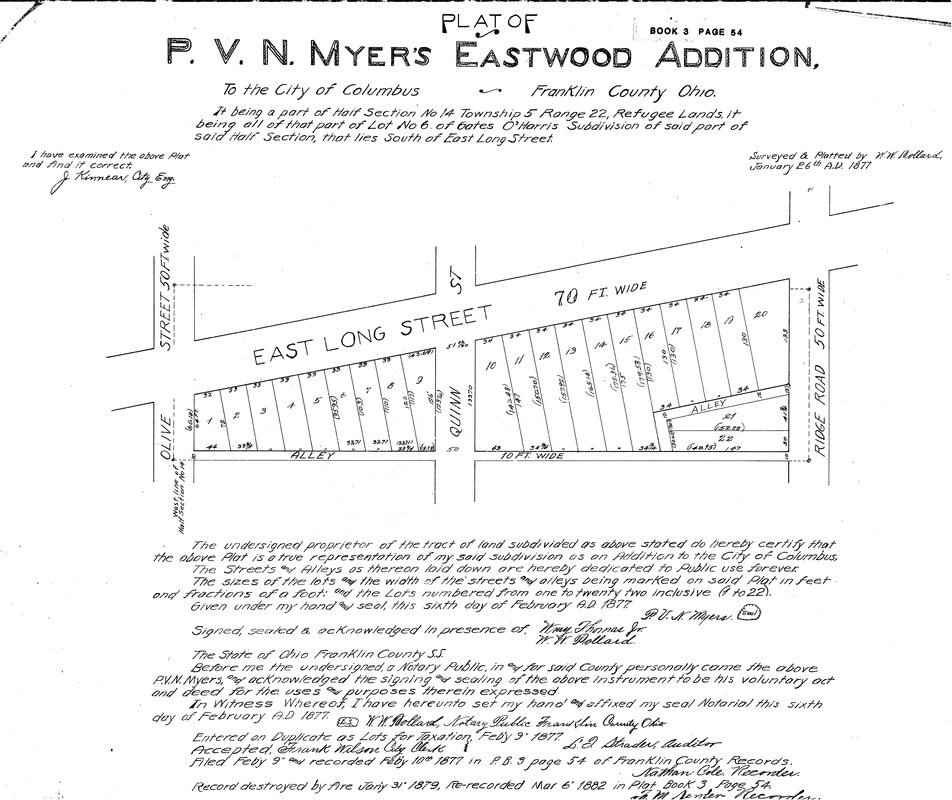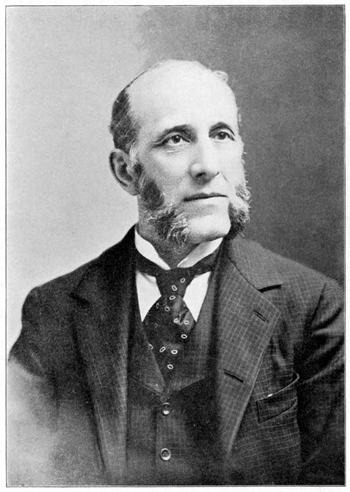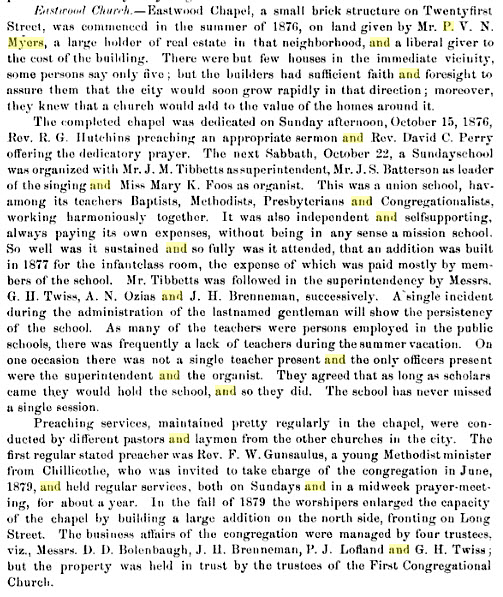P.V.N. Myers' Eastwood AdditionPhilip Van Ness Myers, is listed in the 1875 City Directory at 44 Chestnut Street. He apparently lived in Columbus only a short time, between 1874 and 1878.
The Biographical Encyclopedia of Ohio of the Nineteenth Century" by Galaxy Publishing Co., in 1876, has this biographical sketch of Myers. "Lawyer and Author, was born, August 10th, 1846, at Tribes Hill, Montgomery county, New York. His father, Jacob Myers, was a physician, and of Dutch descent. Through his mother (Katherine Morris) he was allied to the Morris family, whose genealogy, carefully preserved in some of its branches, is carried back to Elysian Glodrydd, a British chieftain, prince of Ferbys, founder of the fourth royal tribe of Wales. The ancestor of the branch of the family in America was Thomas Morris, who arrived in Massachusetts in 1637. The following year he removed from Boston to Quinnipiac, now New Haven, where he purchased the tract of land still known as Morris's Point. In 1850 the parents of Phillip Van Ness Myers removed to Saratoga Springs, where he received his first academic training. Completing his preparation for college at Ballston Spa, New York, he entered Williams College Massachusetts, in 1866, becoming a member of the class of '68. While a student at Williams he was chosen by the Lyceum of Natural History of that institution a member of a scientific expedition to South America. The party, comprising seven persons, made an adventurous and successful journey across the continent along the line of the equator. Phillip Myers, in connection with his brother, H.M. Myers, gave the public the results of this expedition in a volume entitled "Life and Nature under the Tropics." At the close of his college course he assumed the principalship of Pompey Academy, New York, giving up this position after one year to take charge of Naples Academy in the same state. The year 1871 he spent at Williamstown, Massachusetts, devoting himself to studies preparatory to a contemplated tour around the world. In 1872, accompanied by the brother already mentioned as his companion in South American travels, he visited Europe, and the following year made extended journeys through several of the countries of Asia which lie out of the usual course of travellers. The sites of Palmyra, Nineveh, Babylon, and Persepolis were visited and several months were spent by the brothers among the Himalayas of India, the hot season of the Indian year being thus turned to account in botanical and geological studies. His brother having died of fever in India, P.V.N. Myers upon his return home commenced the preparation of a history which should embrace the results of their united travels in Asia. This work, under the title "Remains of Lost Empires," was issued by Harper & Brothers in the fall of 1874. The work soon passed through two editions. While engaged in the preparation of the above-named volume for the press, Mr. Myers was prosecuting the study of law at the Yale Law School. He here divided with a fellow student the prize, open to both classes, for the best essay on the constitutional law of the United States. In 1874, he removed to Columbus, Ohio, continuing there his legal studies. The following year he was married to Ida C Miller of Pompey Hill, New York. He was admitted to the bar in 1875, and is at present engaged in the practice of law at Columbus, Ohio." "Eastwood Chapel, a small brick building on Twenty first Street, was commenced in the summer of 1876, on land given by Mr. P.V.N. Myers, a large holder of real estate in that neighborhood, and a liberal giver to the cost of the building. There are but few houses in the immediate vicinity, some persons say only five; but the buildres had sufficient faith and foresight to assure them that the city would soon grow rapidly in that direction; moreover, they knew that a church would add to the value of homes around it." Philip Van Ness Myers wrote several popular textbooks in history. He gained knowledge of historical locations from trips he went on. On one expedition, he had to bury his brother in the wilds of the Amazon Valley. He received abuse and denunciation because his books accepted the Theory of Evolution, yet he went to church. Timeline
The writings of Professor Myers include:
|
- Home
- Broad Street
- Brunson Place
- Callender Avenue
- Clifton Avenue
- Eastwood Avenue
- Eldridge Avenue
- Emerald Avenue
- Granville Street
- Greenway Avenue
- Harvard Avenue
- Hawthorne Avenue
- Hawthorne Park
- Long Street
- Maryland Avenue
- Menlo Place
- Monypeny Avenue
- Mt. Vernon Avenue
- Parkwood Avenue
- Pembroke Avenue
- Richmond Avenue
- Taylor Avenue
- Vogel Avenue
-
Woodland Avenue
- 44 Woodland Avenue
- 45 Woodland Avenue
- 71 Woodland Avenue
- 93 Woodland Avenue
- 105 Woodland Avenue
- 156 Woodland Avenue
- 190 Woodland Avenue
- 205 Woodland Avenue
- 213 Woodland Avenue
- 214 Woodland Avenue
- 254 Woodland Avenue
- 263 Woodland Avenue
- 264 Woodland Avenue
- 282 Woodland Avenue
- 283 Woodland Avenue
- 298 Woodland Avenue
- 391 Woodland Avenue
- 402 Woodland Avenue
- Adjacent Areas
Updated sporadically and as time permits. Some files are being transferred and updated from the original blog, still available at www.dornberghouse.blogspot.com
Some pages in progress may be temporarily inaccessible or password protected.
Contact
Some pages in progress may be temporarily inaccessible or password protected.
Contact


